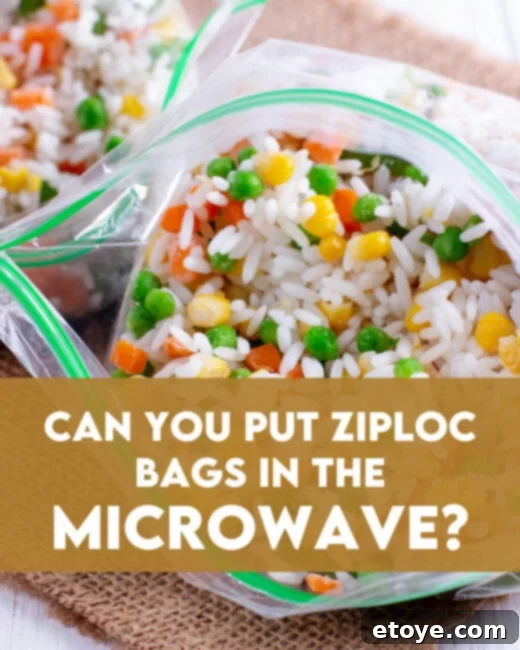We’ve all been there: standing in front of the microwave, a container of delicious leftovers in one hand, and a trusty Ziploc bag in the other. A common question pops into mind, “Is it really safe to put this Ziploc bag in the microwave?” It’s a modern-day kitchen dilemma, born from our quest for convenience and efficiency in reheating meals. The concern isn’t just about whether the plastic will melt, but more significantly, about potential health implications. In our fast-paced lives, quick solutions are often sought for defrosting and reheating food, yet this convenience brings a critical need for clear information regarding microwave safety and the use of plastic containers.
The good news is, you no longer have to guess! This comprehensive guide is designed to provide you with definitive answers, separating fact from fiction. We’ll explore the science behind microwave heating, address common concerns about plastic, and offer straightforward best practices for using Ziploc bags safely. Whether you’re a busy parent juggling meals, a seasoned meal-prepper, or simply someone who appreciates the comfort of reheated leftovers, this article will equip you with the knowledge to microwave with confidence and peace of mind.
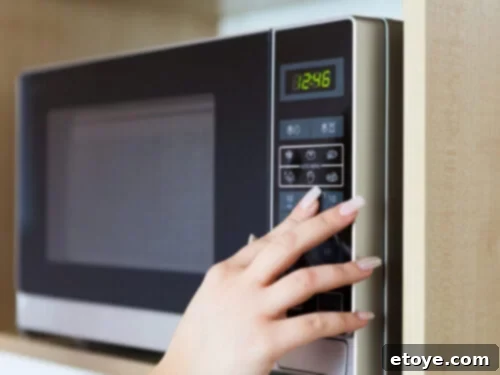
Understanding Microwave Safety: What You Need to Know
Before we delve into the specifics of Ziploc bags, it’s essential to establish a foundational understanding of microwave operation and the general safety principles of heating materials within them. This knowledge empowers you to make informed decisions for all your microwave-related tasks.
How Do Microwaves Work to Heat Food?
Microwave ovens utilize electromagnetic radiation, specifically microwaves, to heat food. These waves penetrate food and cause the water molecules within it to vibrate rapidly. This molecular friction generates heat, efficiently cooking or reheating food from the inside out. This unique heating mechanism explains why some materials interact differently with microwaves, necessitating caution when selecting containers. Unlike conventional ovens that heat food from the outside, microwaves create heat directly within the food itself, making material choice paramount for safety and efficiency.
Key Concerns When Heating Plastic in a Microwave
Heating plastic in a microwave presents several legitimate concerns that consumers should be aware of. Understanding these risks helps underscore the importance of using appropriate containers:
- Chemical Leaching: Perhaps the most significant concern is the potential for harmful chemicals to migrate from the plastic into your food. Certain plastics, especially when subjected to high heat, can release substances like phthalates or, in some cases, Bisphenol A (BPA) – although many modern food storage plastics are now BPA-free. These chemicals can disrupt hormonal balance and have other potential health implications. Therefore, selecting plastics specifically designed for microwave use is crucial.
- Melting and Warping: Not all plastics are created equal in their heat resistance. Plastics not designed for microwave temperatures can soften, melt, or warp when exposed to the intense heat generated. This not only renders your container unusable but can also introduce undesirable plastic particles and chemicals into your food, making it unsafe to consume.
- Uneven Heating: Microwaves often heat food unevenly, creating “hot spots” and “cold spots.” This can be problematic for food safety, particularly with meats and other perishable items, where cold spots might harbor bacteria. While not directly a plastic issue, it’s a general microwave concern that can exacerbate plastic-related risks if the plastic container itself isn’t designed to withstand potential localized superheating. Stirring food midway through heating and allowing it to rest can help mitigate this.
- Pressure Buildup: Heating food in sealed, unvented containers or bags can lead to a dangerous buildup of steam pressure. This pressure can cause the container to burst open, potentially resulting in a messy explosion inside your microwave, food splattering, or even severe burns from hot food and steam. Proper venting is therefore a non-negotiable safety practice.
The Critical Importance of Using Microwave-Safe Materials
Given these concerns, the decision to use microwave-safe materials isn’t just a recommendation; it’s a fundamental aspect of food safety and appliance longevity. Adhering to these guidelines ensures both your health and the proper functioning of your microwave:
- Adherence to Food Safety Standards: Always opt for materials that meet stringent safety requirements, such as those set by the U.S. Food and Drug Administration (FDA). These materials undergo rigorous testing to ensure they can withstand microwave temperatures without degrading, melting, or releasing harmful substances into food. Look for the “microwave-safe” symbol on containers, which typically indicates compliance with these standards.
- Superior Alternatives to Plastic: Whenever feasible, using alternatives like glass or ceramic containers is highly recommended. These materials are inherently microwave-safe, chemically inert, and do not pose the same concerns regarding chemical leaching or melting. They offer a foolproof way to heat your food safely and evenly, providing peace of mind regardless of heating duration or power levels. While plastic offers convenience, glass and ceramic provide unparalleled safety and durability.
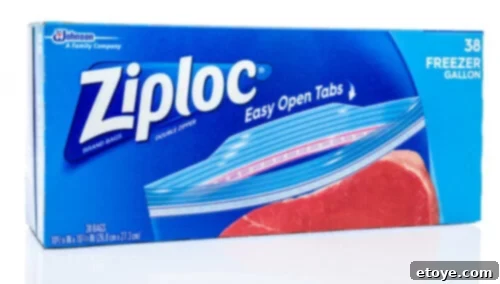
All About Ziploc Bags: What Makes Them Different?
Ziploc bags have become an indispensable part of countless kitchens, synonymous with convenient food storage. However, understanding their specific composition and intended uses is vital when considering their interaction with microwave ovens.
The Basics of Ziploc Brand Bags
- Material Composition: Most Ziploc brand bags are crafted from Low-Density Polyethylene (LDPE) plastic. LDPE is prized for its flexibility, durability, and resilience at varying temperatures, making it ideal for food storage applications. This material is designed to be stable and chemically inert under normal storage and moderate heating conditions, distinguishing it from many other plastics.
- Versatile Applications: Beyond their primary use for storing leftovers, Ziploc bags are incredibly versatile. They are frequently used for organizing ingredients for meal prep, marinating meats and vegetables, protecting produce, and even for non-food storage around the house. Their airtight seal helps preserve freshness and prevent freezer burn, making them a go-to choice for various kitchen tasks.
Ziploc Bags Versus Generic Plastic Bags: A Crucial Distinction
It’s important to recognize that not all plastic bags are created equal, especially when it comes to microwave use. There’s a significant difference between a robust Ziploc storage bag and other types of plastic bags you might encounter:
- Material and Design Differences: Standard plastic bags, such as those used for groceries, deli items, or bread, are typically made from thinner, less heat-resistant plastics. These are designed for temporary containment and are not engineered to withstand the high temperatures of a microwave. In contrast, Ziploc bags are manufactured with a thicker gauge LDPE, formulated to endure higher temperatures and more rigorous use. This specific design allows them to safely handle certain levels of heat that would compromise weaker plastics.
- Prioritizing Safety Through Design: Ziploc bags, particularly those intended for food, undergo testing to ensure they meet the safety requirements of the U.S. Food and Drug Administration (FDA) for food contact. This includes testing for chemical migration at various temperatures. Unlike flimsy plastic wraps or single-use containers, Ziploc products are generally a safer choice for brief microwave exposure, provided specific guidelines are followed. They are significantly safer than improvised plastic containers like water bottles or margarine tubs, which were never intended for microwave use.
- The Importance of Label Directions: Always make it a habit to check the packaging of any sealable bag for specific instructions. Many Ziploc products and similar sealable bags clearly indicate whether they are suitable for microwave use, often accompanied by usage recommendations like “vent before heating” or “use for reheating only.” These instructions are the most reliable guide to ensure safe product usage.
Addressing Chemical Concerns with Ziploc Products
The general concern about plastic and heat often revolves around the leaching of potentially harmful chemicals into food. While this is a valid concern for many plastics, Ziploc has taken significant steps to address it:
- BPA-Free Assurance: A major reassurance for consumers is that the vast majority of Ziploc brand bags are Bisphenol A (BPA)-free. BPA is a chemical often found in polycarbonate plastics and epoxy resins, and its potential health effects have led many manufacturers, including Ziploc, to eliminate it from their food contact products. This commitment helps alleviate one of the primary health concerns associated with heating plastics.
- FDA Compliance: Ziploc products are designed and manufactured to meet the rigorous safety requirements of the U.S. Food and Drug Administration (FDA) for food contact materials. This means they are evaluated for their chemical stability and the potential for substances to migrate into food under intended use conditions. While this provides a strong safety foundation, it’s still crucial to use them as directed, especially concerning temperature limits and venting, to maintain their integrity and safety during microwaving.
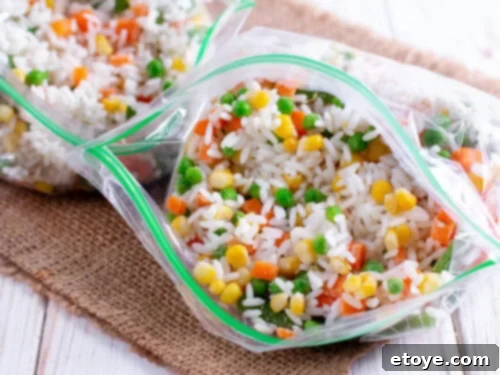
Can I Microwave Ziploc Bags? The Definitive Guide to Safe Practices
Now, let’s address the central question directly: can you put Ziploc bags in the microwave? The concise answer is yes, with important caveats and adherence to specific best practices. Ziploc bags can be used for reheating and defrosting in the microwave, but they are not designed for cooking or prolonged high-temperature exposure. Understanding these nuances is key to safe and effective use.
Understanding the Temperature Thresholds of Ziploc Bags
To safely microwave Ziploc bags, it’s essential to respect their material limits:
- Softening Point: Ziploc brand bags, made from LDPE, typically have a softening point around 195 degrees Fahrenheit (90.5 degrees Celsius). When the internal temperature of the food or the bag itself approaches or exceeds this point, the plastic will begin to soften, lose its structural integrity, and could potentially warp or melt. This is why high heat settings and prolonged microwaving are risky.
- Recommended Microwaving Temperature: To maintain the bag’s integrity and minimize any potential risks, it is generally recommended to keep the internal food temperature around 170 degrees Fahrenheit (76.7 degrees Celsius) or below when using Ziploc bags in the microwave. Utilizing a lower power setting on your microwave is an excellent strategy to achieve more gradual and controlled heating, which helps prevent the bag from reaching its softening point and ensures the food heats through without compromising the plastic.
Essential Best Practices for Microwaving Food in Ziploc Bags
Follow these guidelines meticulously to ensure a safe and successful experience:
- Use as a Reheating Container, Not for Cooking: Ziploc bags are designed for storage and gentle reheating, not for cooking raw food or heating items that require extended, high-temperature exposure. The distinction is crucial: warming up already cooked food briefly is acceptable, but attempting to cook something from scratch in a Ziploc bag is not recommended due to the intense and sustained heat required for proper cooking.
- Always Place on a Microwave-Safe Dish: Ziploc bags are flexible and not designed to stand upright independently in the microwave. Always place the bag containing your food onto a sturdy, microwave-safe plate or dish. This prevents spills if the bag tips over and provides a crucial safeguard against potential leaks. Unnoticed small punctures or tears in the bag could lead to food spilling directly onto your microwave’s interior, creating a mess and potentially damaging the appliance.
- Never Use a Vacuum-Sealed Bag for Microwaving: Do not attempt to microwave food in a bag that has been vacuum-sealed. These bags are designed to create an airtight seal for storage, not to withstand the rapid internal pressure buildup that occurs during microwaving. Heating a sealed bag can lead to a dangerous explosion as steam has nowhere to escape, potentially causing injury or significant damage to your microwave.
- Venting is Absolutely Crucial: This is a non-negotiable step. Always leave a small corner of the Ziploc bag open (about an inch) or make a small slit with a knife before microwaving. This simple action allows steam to escape safely, preventing dangerous pressure buildup inside the bag that could otherwise cause it to rupture or burst open. Proper venting ensures even heating and prevents hazardous situations.
- Avoid High Temperatures and Use Lower Power Settings: To prevent the plastic from overheating, softening, or melting, avoid using your microwave’s highest power settings. Opt for a medium or low power setting, even if it means extending the heating time slightly. This provides a more controlled heating process, reducing the risk of plastic degradation and ensuring the food warms thoroughly without scorching or creating excessively hot spots in the bag.
- Monitor Heating Time and Never Overheat: Keep a close eye on your food while it’s in the microwave. It’s best to heat in short intervals, such as 30-second bursts, stirring or shaking the bag gently between intervals (after carefully removing it) to ensure even heat distribution. Overheating can quickly cause the plastic to melt and compromise the food. For safety and hygiene, it’s recommended to discard the Ziploc bag after a single use for reheating; do not reuse the same bag for another meal after it has been microwaved.
- When in Doubt, Transfer to a Microwave-Safe Container: If you are ever unsure about the safety of microwaving food in a particular Ziploc bag or any plastic container, the safest approach is to transfer the food to a known microwave-safe glass or ceramic dish. This provides complete assurance that your food will heat evenly and safely, free from any concerns about plastic integrity or chemical leaching.
The Exception to the Rule: Ziploc Endurables®
While standard Ziploc bags have specific temperature limitations, Ziploc offers a specialized product line designed for extreme versatility and heat endurance:
- Engineered for High-Temperature Applications: Ziploc Endurables® Large Silicone Pouches stand as a significant exception to the typical Ziploc temperature guidelines. These innovative pouches are specifically designed to be boilable, oven-safe (up to 425°F/218°C), freezer-safe, and, of course, microwave-safe. Their robust construction allows them to transition seamlessly from freezer to oven to table, making them a remarkably versatile tool for cooking, reheating, and storage.
- Premium Material and Enhanced Durability: Crafted from durable and reusable platinum silicone, Ziploc Endurables® offer exceptional resistance to extreme temperatures. This high-quality silicone is not only incredibly resilient but also non-toxic and food-grade, providing peace of mind for various cooking and reheating needs, including direct contact with boiling water or high oven temperatures. Their reusable nature also makes them an environmentally friendly choice compared to single-use bags.
After Microwaving: Important Post-Heating Steps
- Handle with Extreme Care: Once the microwaving cycle is complete, exercise caution when handling the Ziploc bag. The contents will be hot, and steam can escape rapidly and intensely when the bag is fully opened. Use oven mitts or a towel to protect your hands, and open the bag away from your face to avoid steam burns.
- Inspect for Damage and Discard if Necessary: Before serving or consuming the food, visually inspect the Ziploc bag for any signs of melting, warping, discoloration, or deformation. If you notice any changes in the plastic’s integrity, it is strongly advised to discard both the bag and its contents. While Ziploc bags are designed to be safe, plastic that has been compromised by excessive heat should not be used, and the food contained within should not be eaten.
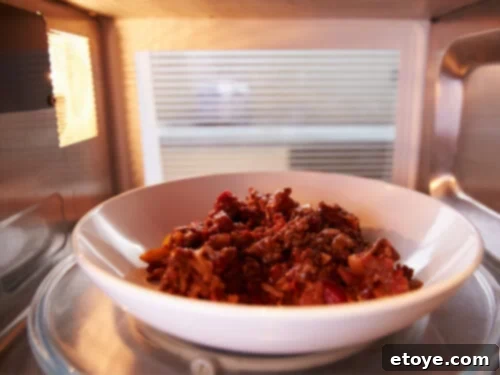
Frequently Asked Questions About Microwaving Other Materials
Beyond Ziploc bags, many questions arise about the microwave safety of other common kitchen items. Here are answers to some of the most frequently asked questions:
Q: What types of containers are generally safe to use in the microwave?
A: The safest choices for microwave use are containers made of glass, ceramic (without metallic glazes or decorations), and certain plastics specifically labeled “microwave-safe.” These materials are designed to withstand microwave radiation and heat without breaking down or leaching harmful chemicals. Always look for the explicit “microwave-safe” symbol, which typically resembles a microwave with wavy lines or a “PP” (polypropylene) symbol, indicating a heat-resistant plastic.
Q: Can I use takeout containers or plastic tubs (like yogurt or margarine) in the microwave?
A: It’s generally best to avoid microwaving takeout containers and single-use plastic tubs. While some takeout containers may claim to be microwave-safe, many are not designed for repeated heating or high temperatures and can melt, warp, or leach chemicals into your food. Containers for yogurt, cottage cheese, margarine, or similar products are usually made from thin plastics that are not heat-resistant and should never be microwaved. Always transfer food from these containers to a microwave-safe dish for reheating.
Q: How can I definitively tell if a container is microwave-safe?
A: The most reliable way is to look for a microwave-safe symbol or label on the bottom or side of the container. This symbol often depicts a microwave oven with wavy lines, or sometimes a simple “microwaveable” text. If no such symbol is present, or if you’re uncertain, it’s always safer to err on the side of caution and transfer your food into a glass or ceramic container that you know is safe for microwave use.
Q: Are there any specific health risks associated with microwaving food in plastic containers?
A: The primary health risk associated with microwaving food in non-microwave-safe plastic containers is the potential for harmful chemicals, such as phthalates or trace amounts of BPA (even if BPA-free, other chemicals can be a concern), to leach into your food when the plastic is heated. These chemicals can act as endocrine disruptors or have other adverse health effects. Using plastics that are clearly labeled “BPA-free” and “microwave-safe” significantly reduces this risk, as they are tested to ensure chemical stability under microwave conditions.
Q: Can aluminum foil be used in the microwave?
A: Absolutely not. Never use aluminum foil or any metal in the microwave. Metals are highly reflective to microwaves and can cause electrical arcing, leading to sparks, fire hazards, and potential damage to your microwave oven. Always remove food from aluminum foil or containers with metal components before microwaving.
Q: Is it safe to reheat food in Styrofoam containers in the microwave?
A: It is strongly advised to avoid microwaving Styrofoam containers. Styrofoam (polystyrene foam) can melt and degrade at high microwave temperatures, potentially releasing harmful chemicals into your food. This can not only contaminate your meal but also ruin the container. Always transfer food from Styrofoam to a microwave-safe dish made of glass or ceramic.
Q: If a container is marked “dishwasher safe,” does that mean it’s also microwave-safe?
A: Not necessarily. “Dishwasher safe” and “microwave-safe” are distinct certifications based on different performance standards. Dishwasher safety relates to a container’s ability to withstand hot water, detergents, and drying cycles. Microwave safety, however, pertains to its stability and chemical inertness under direct exposure to microwave radiation and high internal food temperatures. Always look for the specific microwave-safe symbol if you intend to use a container in the microwave.
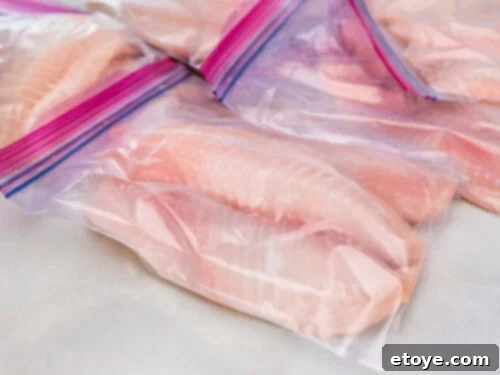
Now You’re Equipped with Knowledge!
We hope this comprehensive guide has demystified the process of microwaving with Ziploc bags, providing you with clear, actionable insights to enhance your kitchen safety and efficiency. Understanding the science, recognizing the right materials, and diligently following best practices are all crucial steps toward a safer and more convenient culinary experience.
Microwaving food in Ziploc bags can indeed be a valuable time-saver for those hectic days or when quick meal prep is essential, provided it’s done wisely and safely. By adhering to the guidelines regarding temperature thresholds, proper venting, using a supporting dish, and avoiding overheating, you can confidently integrate Ziploc bags into your reheating routine. And for those seeking ultimate versatility, remember the specialized Ziploc Endurables® designed for even more demanding cooking scenarios.
So go ahead, reheat your leftovers with renewed confidence, enjoying the practical convenience that Ziploc bags offer when used correctly. We encourage you to share your own microwaving tips, experiences, or any further questions you might have in the comments section below. Let’s keep the conversation cooking and continue to learn from each other!
